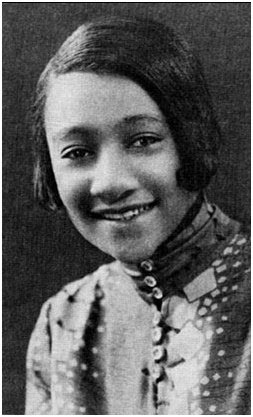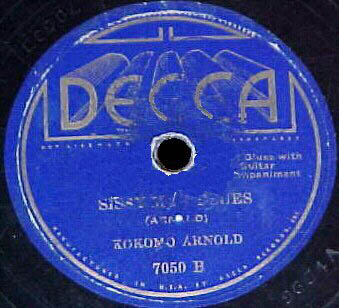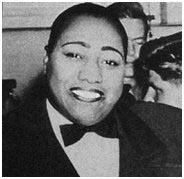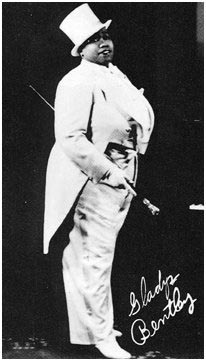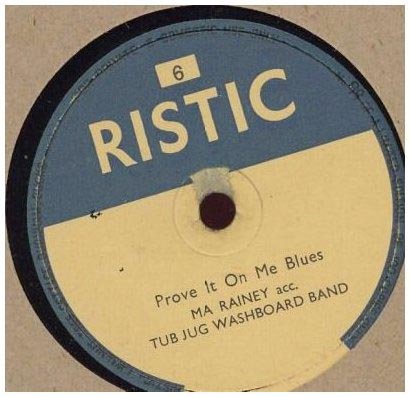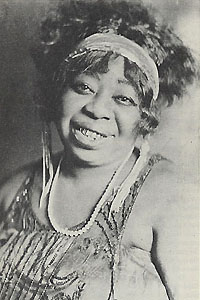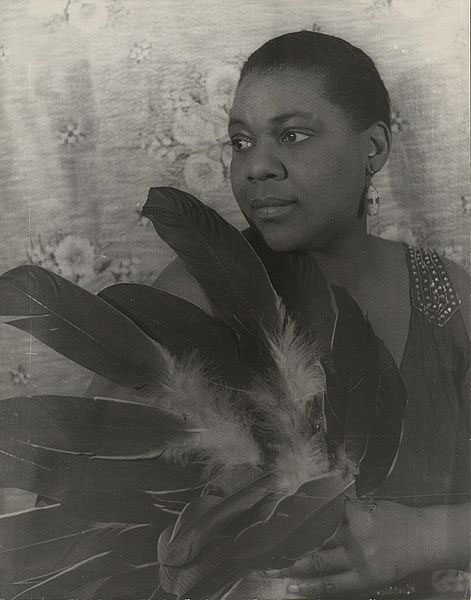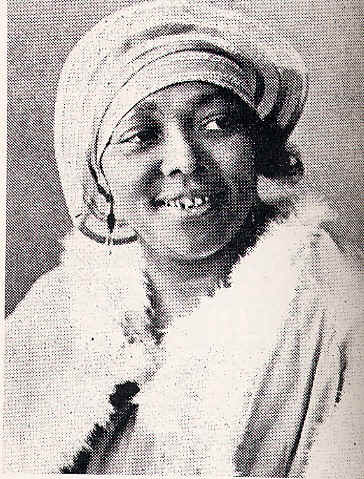Difference between revisions of "Singing the Blues: Masculine Female Performers"
(ref +ref +ref +ref +ref +ref +ref +ref) |
|||
| Line 2: | Line 2: | ||
| − | Masculine blues singers | + | Masculine blues singers enjoyed a great popularity in Bronzeville’s cabarets in the twenties. |
[[Image:BluesAlbertaHunter.jpg |frame|none|Alberta Hunter, who was very popular in South Side cabarets and lived in Bronzeville in the 1920s, recorded several queer-themed songs.]] | [[Image:BluesAlbertaHunter.jpg |frame|none|Alberta Hunter, who was very popular in South Side cabarets and lived in Bronzeville in the 1920s, recorded several queer-themed songs.]] | ||
| − | Blues singers, such as Gladys Bentley, Alberta Hunter | + | Blues singers, such as [http://en.wikipedia.org/wiki/Gladys_Bentley Gladys Bentley], [http://en.wikipedia.org/wiki/Alberta_Hunter Alberta Hunter], and [http://en.wikipedia.org/wiki/Ma_Rainey ‘Ma’ Rainey], who were all popular at the end of the 1920’s, often performed in Chicago and had recorded numerous sexually explicit songs that included descriptions of homosexual acts.<ref>Sandra Lieb, Mother of the Blues: a Study of Ma Rainey (Amherst: University of Massachusetts Press, 1981), Hazel Carby, « It just be’s Dat Way Sometime: The Sexual Politcs of Women’s Blues » Radical America 20;4 (June-July 1986), 9-22; Lilian Faderman, Odd Girls and Twilight Lovers: A History of Lesbian Life in Twentieth Century America (1991; New York: Penguin Books, 1992) 74-75 </ref> |
| Line 13: | Line 13: | ||
| − | The sissies and “bulldaggers” mentioned in the blues were ridiculed for their cross gender behavior, but neither shunned nor hated. In “Boy in the Boat” for example, the author counseled, “When you see two women walking hand in hand, just shake your head and try to understand.” | + | The sissies and “bulldaggers” mentioned in the blues were ridiculed for their cross gender behavior, but neither shunned nor hated. In the famous tune “Boy in the Boat” for example, the author counseled, “When you see two women walking hand in hand, just shake your head and try to understand.” |
| − | In fact, the casualness toward sexuality, so common in the blues, sometimes extended to homosexual behavior. In “Sissy Man Blues,” a traditional tune recorded by numerous male blues singers, the singer demanded, “If you can’t bring a woman, bring me a sissy man.” | + | In fact, the casualness toward sexuality, so common in the blues, sometimes extended to homosexual behavior. In “Sissy Man Blues,” a traditional tune recorded by numerous male blues singers, the singer demanded, “If you can’t bring a woman, bring me a sissy man.” <ref>for more information, read http://www.queermusicheritage.us/feb2004smb.html</ref> |
| − | [[Image:BluesSissyBlues.jpg|frame|none| | + | [[Image:BluesSissyBlues.jpg|frame|none|In “Sissy Man Blues,” a traditional tune recorded by numerous male blues singers, the singer demanded, “If you can’t bring a woman, bring me a sissy man.”]] |
| Line 28: | Line 28: | ||
| − | + | Bentley appeared at several gay-friendly clubs in New York and Chicago in the 1920s, where she was usually backed up by a chorus line of drag queens. Often dressed in men's clothes, Bentley played the piano and sang her own raunchy lyrics to popular tunes, while flirting with women in the audience.<ref>http://www.glbtq.com/arts/bentley_g.html</ref> | |
| + | [[Image:BluesBentley.jpg|frame|none|Often dressed in men's clothes, Bentley played the piano and sang her own raunchy lyrics to popular tunes, while flirting with women in the audience.]] | ||
| + | She was frequently harassed for wearing men's clothing and claimed that she had married a white woman in Atlantic City.<ref>http://www.queerculturalcenter.org/Pages/Bentley/BentleyBio.html</ref> | ||
| − | [[Image:BluesBentleyHat.jpg|frame|none| | + | [[Image:BluesBentleyHat.jpg|frame|none|Bentley was frequently harassed for wearing men's clothing]] |
| + | An open lesbian during her early career, she married a man (who denied that they ever married), and clamed to have been "cured" by taking female hormones in the 1950s.<ref>Duberman, Martin; Vicinus, Martha; Chauncey, George (1990), Hidden from History, Penguin, ISBN 0452010675</ref> | ||
== Gertrude Ma Rainey == | == Gertrude Ma Rainey == | ||
| − | In 1928, Gertrude ‘Ma’ Rainey, a South Side resident, stated in a song she wrote entitled “Prove it on Me Blues | + | In 1928, Gertrude ‘Ma’ Rainey, a South Side resident, stated in a song she wrote - entitled “Prove it on Me Blues" - that “she [wore] a collar an tie,” and “talk[ed] to the gals just like any old man.” |
| − | [[Image:BluesProveItOnMeBlues.jpg|frame|none| | + | [[Image:BluesProveItOnMeBlues.jpg|frame|none|In 1928, Gertrude ‘Ma’ Rainey, a South Side resident, stated in a song she wrote - entitled “Prove it on Me Blues" - that “she [wore] a collar an tie,” and “talk[ed] to the gals just like any old man.”]] |
| Line 52: | Line 55: | ||
They must've been women, 'cause I don't like no men | They must've been women, 'cause I don't like no men | ||
It's true I wear a collar and a tie... | It's true I wear a collar and a tie... | ||
| − | Talk to the gals just like any old man... | + | Talk to the gals just like any old man...<ref>Gertrude Ma Rainey, “Prove It on me Blues,” Paramount 12668, June 1928, as transcribed in Angela Davis, Blues Legacies and Black Feminism: Gertrude Ma Rainey, Bessie Smith and Billie Holliday (New York: Pantheon, 1998), 238-39 </ref> |
| + | [[Image:BluesMaRainey.jpg|frame|none|Blues Singer Ma Rainey]] | ||
| − | |||
| − | + | A 1928 advertisement for this recording in the Chicago Defender illustrated these verses with a drawing of voluptuous woman (Rainey) wearing a jacket and tie, chatting with two very feminine women. The advertisement suggested “scandal” by directing the audience’s eyes toward a police officer who watched the women from across the street.<ref>; « Advertisement or Paramount Records, » Chicago Defender, September 22, 1928</ref> | |
| − | A 1928 advertisement for this recording in the Chicago Defender illustrated these verses with a drawing of voluptuous woman (Rainey) wearing a jacket and tie, chatting with two very feminine women. The advertisement suggested “scandal” by directing the audience’s eyes toward a police officer who watched the women from across the street. | ||
| Line 86: | Line 88: | ||
| − | [[Image:BluesBessieSmith.jpg|frame|none| | + | [[Image:BluesBessieSmith.jpg|frame|none|Blues Singer Bessie Smith]] |
| Line 98: | Line 100: | ||
[[Media:Bogan.mp3|B.D. Women Blues]] | [[Media:Bogan.mp3|B.D. Women Blues]] | ||
| − | Lucille Bogan, in her “B.D. Women Blues,” warned that “B.D. women sure [were] rough” because “they dr[a]nk up many a whiskey and they sure [could] strut their stuff.” | + | Lucille Bogan, in her “B.D. Women Blues,” warned that “B.D. women sure [were] rough” because “they dr[a]nk up many a whiskey and they sure [could] strut their stuff.”<ref>For more information, read: http://www.windycitymediagroup.com/gay/lesbian/news/ARTICLE.php?AID=20010</ref> |
| + | |||
| + | |||
| + | [[Image:BluesBogan.jpg|frame|none|Blues Singer Lucille Bogan]] | ||
| − | + | <references/> | |
Revision as of 18:25, 14 March 2009
The Popularity of Masculine Female Blues Singers
Masculine blues singers enjoyed a great popularity in Bronzeville’s cabarets in the twenties.
Blues singers, such as Gladys Bentley, Alberta Hunter, and ‘Ma’ Rainey, who were all popular at the end of the 1920’s, often performed in Chicago and had recorded numerous sexually explicit songs that included descriptions of homosexual acts.[1]
Gay Blues?
The sissies and “bulldaggers” mentioned in the blues were ridiculed for their cross gender behavior, but neither shunned nor hated. In the famous tune “Boy in the Boat” for example, the author counseled, “When you see two women walking hand in hand, just shake your head and try to understand.”
In fact, the casualness toward sexuality, so common in the blues, sometimes extended to homosexual behavior. In “Sissy Man Blues,” a traditional tune recorded by numerous male blues singers, the singer demanded, “If you can’t bring a woman, bring me a sissy man.” [2]
The blues reflected a culture that accepted sexuality, including homosexual behavior and identities, as a natural part of life.
Gladys Bentley
Bentley appeared at several gay-friendly clubs in New York and Chicago in the 1920s, where she was usually backed up by a chorus line of drag queens. Often dressed in men's clothes, Bentley played the piano and sang her own raunchy lyrics to popular tunes, while flirting with women in the audience.[3]
She was frequently harassed for wearing men's clothing and claimed that she had married a white woman in Atlantic City.[4]
An open lesbian during her early career, she married a man (who denied that they ever married), and clamed to have been "cured" by taking female hormones in the 1950s.[5]
Gertrude Ma Rainey
In 1928, Gertrude ‘Ma’ Rainey, a South Side resident, stated in a song she wrote - entitled “Prove it on Me Blues" - that “she [wore] a collar an tie,” and “talk[ed] to the gals just like any old man.”
They said I do it, ain't nobody caught me
Sure got to prove it on me
Went out last night with a crowd of my friends
They must've been women, 'cause I don't like no men
It's true I wear a collar and a tie...
Talk to the gals just like any old man...[6]
A 1928 advertisement for this recording in the Chicago Defender illustrated these verses with a drawing of voluptuous woman (Rainey) wearing a jacket and tie, chatting with two very feminine women. The advertisement suggested “scandal” by directing the audience’s eyes toward a police officer who watched the women from across the street.[7]
In “Sissy Blues,” Ma Rainey complained of her husband’s infidelity with a homosexual named “Miss Kate.”
I came in last night I'm going home tonight, I won't no more "Hello, Central, it's 'bout to run me wild Can I get that number, or will I have to wait a while?" I dreamed last night I was far from harm Woke up and found my man in a sissy's arms "Hello, Central, it's 'bout to run me wild Can I get that number, or will I have to wait a while?" Some are young, some are old My man says sissy's got good jelly roll My man got a sissy, his name is Miss Kate He shook that thing like jelly on a plate "Hello, Central, it's 'bout to run me wild Can I get that number, or will I have to wait a while?" Now all the people ask me why I'm all alone A sissy shook that thing and took my man from me
Bessie Smith
“There’s two things got me puzzled, there’s two things I don’t understand,” moaned blues singer Bessie Smith in "Foolish Man Blues," “that’s a mannish acting woman and a lisping, swishing, womanish-acting man.”
Lucille Bogan
Lucille Bogan, in her “B.D. Women Blues,” warned that “B.D. women sure [were] rough” because “they dr[a]nk up many a whiskey and they sure [could] strut their stuff.”[8]
- ↑ Sandra Lieb, Mother of the Blues: a Study of Ma Rainey (Amherst: University of Massachusetts Press, 1981), Hazel Carby, « It just be’s Dat Way Sometime: The Sexual Politcs of Women’s Blues » Radical America 20;4 (June-July 1986), 9-22; Lilian Faderman, Odd Girls and Twilight Lovers: A History of Lesbian Life in Twentieth Century America (1991; New York: Penguin Books, 1992) 74-75
- ↑ for more information, read http://www.queermusicheritage.us/feb2004smb.html
- ↑ http://www.glbtq.com/arts/bentley_g.html
- ↑ http://www.queerculturalcenter.org/Pages/Bentley/BentleyBio.html
- ↑ Duberman, Martin; Vicinus, Martha; Chauncey, George (1990), Hidden from History, Penguin, ISBN 0452010675
- ↑ Gertrude Ma Rainey, “Prove It on me Blues,” Paramount 12668, June 1928, as transcribed in Angela Davis, Blues Legacies and Black Feminism: Gertrude Ma Rainey, Bessie Smith and Billie Holliday (New York: Pantheon, 1998), 238-39
- ↑ ; « Advertisement or Paramount Records, » Chicago Defender, September 22, 1928
- ↑ For more information, read: http://www.windycitymediagroup.com/gay/lesbian/news/ARTICLE.php?AID=20010
